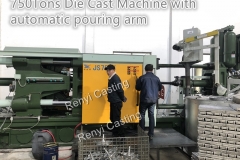Die Casting China Manufacturing - RENYI CASTINGS
Posted by RENYI CASTINGS on January 3rd, 2020
Casting is one of the oldest procedures done on metals. Many products are formed using this method. Here is an attempt to share the knowledge of casting.
Casting is one of four types: sand casting, permanent mold casting, plaster casting and die casting China companies. All these types of castings have their own advantages and disadvantages. Depending on the properties of the product requited, one of the castings is selected.
Sand Casting: Sand casting is the oldest casting of the above. This method of casting is in use since 1950. The texture of the product depends on the sand used for casting. The end product gives smooth finishing at the end. Usually, iron, steel, bronze, brass, aluminum, magnesium alloys which often include lead, tin, and zinc is used.
Permanent mold casting: Permanent mold casting uses two pieces of mold. This mold is joined together and molten metal is poured into this mold. The hot metal is allowed to cool and the mold pieces are separated. Some products have metal extrusion which is removed by flash grind or by hand. Tin, Lead and Zinc are commonly molded using this method.
Plaster casting: Plaster casting is one of the easiest methods. However, it is used for metals with low melting points like Copper, Zinc, and Aluminum. This is the easiest process because mold can be made easily in case it brakes in the procedures.

Die casting: Die casting is done by introducing molten metal into the mold at high or low pressure. Earlier only low-pressure die-casting was used, but nowadays high pressure die casting is used more extensively. Molds are well designed to give complex products with stunning accuracy and smooth finishing. They are made of high-quality steel as steel has a higher melting point. These molds can be reused thousands of times. Casts can be a single cavity that produces only a single component, multiple cavities that produce multiple identical parts at a time, unit dies that produces different parts and combination die that produces different parts in one go. Usually, zinc, copper, aluminum, magnesium, lead, pewter, and tin-based alloys are used for die casting.
Using die casting we can make products with pore-free products that do not allow gas to pass through them and making them strong. Two types of machines are used for die-casting.
Hot-chamber die casting is used for high-fluidity metals. First, the molten metal is collected using gooseneck and then the metal is shot into the mold. The advantage of this method is the cycles/min is increased. But the disadvantage is that high melting point metals and aluminum pick-sup iron particles.
Cold chamber die casting is used where the hot-chamber cannot be used. In this process the molten metal is transferred to the injector and then the injector injects the metal into the mold. Metals with high melting points can be die-cast using this process, but the disadvantage is it is slower than hot-chamber process.
Visit The Website Click Here >> Gravity Castings



